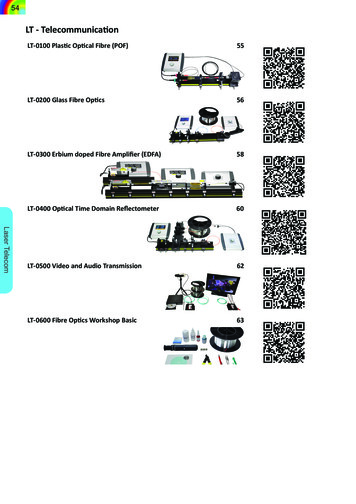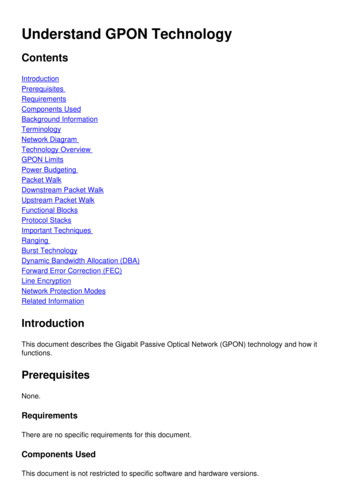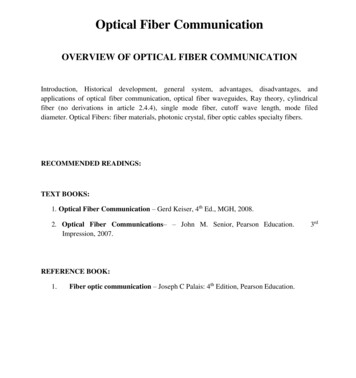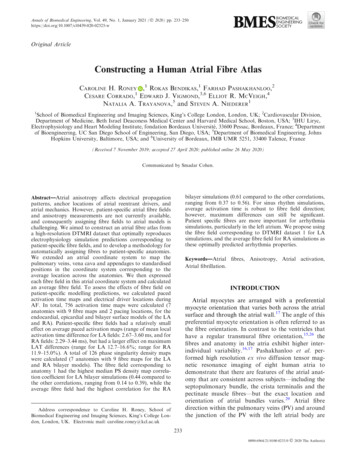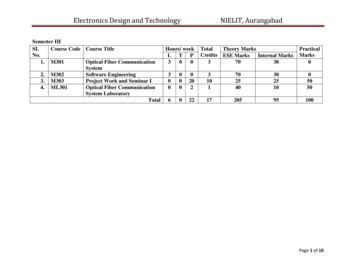
Transcription
Continue
Optical fibre communication by gerd keiserTable of contents : Cover Citation preview Optical Fiber Communications ——Fourth Edition—— Optical Fiber Communications Fourth Edition Gerd Keiser National Taiwan University of Science and Technology OPTICAL FIBER COMMUNICATIONS, FOURTH EDITION Published by McGraw-Hill, a business unit of TheMcGraw-Hill Companies, Inc., 1221 Avenue of the Americas, New York, NY 10020. Copyright 2011 by The McGraw-Hill Companies, Inc. All rights reserved. Previous editions 2000, 1991, and 1983. No part of this publication may be reproduced or distributed in any form or by any means, or stored in a database orretrieval system, without the prior written consent of The McGraw-Hill Companies, Inc., including, but not limited to, in any network or other electronic storage or transmission, or broadcast for distance learning. Some ancillaries, including electronic and print components, may not be available to customers outside theUnited States. This book is printed on acid-free paper containing 10% postconsumer waste. 1 2 3 4 5 6 7 8 9 0 QPD/QPD 1 0 9 8 7 6 5 4 3 2 1 0 ISBN 978-0-07-338071-1 MHID 0-07-338071-7 Vice President & Editor-in-Chief: Marty Lange Vice President EDP/Central Publishing Services: Kimberly Meriwether DavidPublisher: Raghothaman Srinivasan Sponsoring Editor: Peter Massar Marketing Manager: Curt Reynolds Developmental Editor: Lorraine Buczek Senior Project Manager: Lisa A. Bruflodt Design Coordinator: Margarite Reynolds Cover Designer: Carole Lawson Photo Research: Carrie K. Burger Cover Image: NickKoudis/Getty Images Buyer: Nicole Baumgartner Media Project Manager: Yeswini Devdutt Compositor: Glyph International Typeface: 10.5/12 Times Roman Printer: R.R. Donnelley All credits appearing on page or at the end of the book are considered to be an extension of the copyright page. Library of CongressCataloging-in-Publication Data Keiser, Gerd. Optical fiber communications/Gerd Keiser.— 4th ed. p. m. c ISBN 978-0-07-338071-1 (alk. paper) 1. Optical communications. 2. Fiber optics. I. Title. TK5103.59.K44 2011 621.382’75—dc22 2010023150 www.mhhe.com To Ching-yun and Nishla About the Author Gerd Keiseris a National Science Council Chair Professor in the Department of Electronic Engineering at the National Taiwan University of Science and Technology. His teaching and research interests include photonic component development, telecom optical transmission systems, fiber-to-the-premises (FTTP) networks, intelligentbuilding and smart-home networks, and biomedical photonics. In addition, he is the founder and principal consultant at PhotonicsComm Solutions, a firm specializing in consulting and education for the optical communications industry. Previously he worked at Honeywell, GTE, and General Dynamics in the developmentand application of optical network and digital switch technologies. His technical achievements at GTE earned him the prestigious Leslie Warner Award. As an outside activity, he was an adjunct professor at Northeastern University, Tufts University, and Boston University. Dr. Keiser is a Fellow of the IEEE, a member ofOSA and SPIE, an associate editor of the journal Optical Fiber Technology, and the author of four graduate-level books. Brief Contents Chapter 1 Overview of Optical Fiber Communications Chapter 2 Optical Fibers: Structures, Waveguiding, and Fabrication Chapter 3 Attenuation and Dispersion Chapter 4 OpticalSources Chapter 5 Power Launching and Coupling Chapter 6 Photodetectors Chapter 7 Optical Receiver Operation Chapter 8 Digital Links Chapter 9 Analog Links Chapter 10 WDM Concepts and Components Chapter 11 Optical Amplifiers Chapter 12 Nonlinear Effects Chapter 13 Optical Networks Chapter 14Performance Measurement and Monitoring Appendixes Index Contents Preface Acknowledgments 1 xxii xxvii Overview of Optical Fiber Communications 1.1 1.2 1 Motivations for Lightwave Communications 2 1.1.1 The Path to Optical Networks 2 1.1.2 Advantages of Optical Fibers 5 Optical Spectral Bands 5 1.2.1Electromagnetic Energy 5 1.2.2 Windows and Spectral Bands 1.3 Decibel Units 1.4 Network Information Rates 12 8 9 1.4.1 Telecom Signal Multiplexing 1.4.2 SONET/SDH Multiplexing Hierarchy 13 12 1.5 WDM Concepts 1.6 Key Elements of Optical Fiber Systems 15 1.7 Standards for Optical Fiber Communications 191.8 Modeling and Simulation Tools 20 15 1.8.1 Simulation Tool Characteristics 1.8.2 Graphical Programming 21 1.8.3 Example Programs for Student Use 23 20 Problems 23 References 24 2 Optical Fibers: Structures, Waveguiding, and Fabrication 2.1 2.2 The Nature of Light 27 2.1.1 Linear Polarization 2.1.2 Ellipticaland Circular Polarization 2.1.3 The Quantum Nature of Light 28 Basic Optical Laws and Definitions 33 2.2.1 Refractive Index 33 2.2.2 Reflection and Refraction 34 33 31 27 x Contents 2.3 2.4 2.5 2.2.3 Polarization Components of Light 2.2.4 Polarization-Sensitive Materials 38 Optical Fiber Modes and ConfigurationsFiber Types 2.3.2 Rays and Modes 2.3.3 Step-Index Fiber Structure 43 2.3.4 Ray Optics Representation 2.3.5 Wave Representation in a Dielectric Slab Waveguide 45 40 42 43 Mode Theory for Circular Waveguides 47 2.4.1 Overview of Modes 2.4.2 Summary of Key Modal Concepts 2.4.3 Maxwell’s Equations* 2.4.4Waveguide Equations* 2.4.5 Wave Equations for Step-Index Fibers* 54 2.4.6 Modal Equation* 2.4.7 Modes in Step-Index Fibers* 2.4.8 Linearly Polarized Modes* 2.4.9 Power Flow in Step-Index Fibers* 63 Single-Mode Fibers 48 49 51 52 55 57 60 65 2.5.1 Construction 65 2.5.2 Mode-Field Diameter 65 2.5.3 PropagationModes in Single-Mode Fibers 67 Graded-Index Fiber Structure 2.7 Fiber Materials 2.9 39 2.3.1 2.6 2.8 36 68 70 2.7.1 Glass Fibers 2.7.2 Active Glass Fibers 71 2.7.3 Plastic Optical Fibers 71 Photonic Crystal Fibers 70 72 2.8.1 Index-Guiding PCF 2.8.2 Photonic Bandgap Fiber 73 Fiber Fabrication 72 74 2.9.1 OutsideVapor-Phase Oxidation 2.9.2 Vapor-Phase Axial Deposition 2.9.3 Modified Chemical Vapor Deposition 2.9.4 Plasma-Activated Chemical Vapor Deposition 2.9.5 Photonic Crystal Fiber Fabrication 75 75 76 77 76 xi Contents 2.10 Mechanical Properties of Fibers 78 2.11 Fiber Optic Cables 82 2.11.1 Cable Structures2.11.2 Indoor Cable Designs 2.11.3 Outdoor Cables 86 2.12 Cable Installation Methods 83 84 87 2.12.1 Direct-Burial Installations 87 2.12.2 Pulling Cable into Ducts 2.12.3 Cable Jetting Installation 2.12.4 Aerial Installation 90 2.12.5 Under water Installation 2.12.6 Industry Installation Standards 92 88 89 91 Problems 93References 96 3 Attenuation and Dispersion 3.1 3.2 3.3 Attenuation 102 102 3.1.1 Attenuation Units 3.1.2 Absorption 3.1.3 Scattering Losses 108 3.1.4 Bending Losses 111 3.1.5 Core and Cladding Losses 103 104 Signal Dispersion in Fibers 113 114 3.2.1 Overview of Dispersion Origins 3.2.2 Modal Delay 3.2.3 FactorsContributing to Dispersion 3.2.4 Group Delay 3.2.5 Material Dispersion 3.2.6 Waveguide Dispersion 3.2.7 Dispersion in Single-Mode Fibers 3.2.8 Polarization-Mode Dispersion 114 116 118 119 121 123 Characteristics of Single-Mode Fibers 3.3.1 Refractive-Index Profiles 3.3.2 Cutoff Wavelength 3.3.3 DispersionCalculations 3.3.4 Mode-Field Diameter 135 3.3.5 Bending Loss 135 128 128 130 132 124 126 xii Contents 3.4 3.5 International Standards 138 3.4.1 Recommendation G.651.1 3.4.2 Recommendation G.652 138 3.4.3 Recommendation G.653 141 3.4.4 Recommendation G.654 141 3.4.5 Recommendation G.655 1413.4.6 Recommendation G.656 141 3.4.7 Recommendation G.657 142 138 Specialty Fibers 142 Problems 145 References 147 4 Optical Sources 4.1 4.2 4.3 151 Topics from Semiconductor Physics 152 4.1.1 Energy Bands 152 4.1.2 Intrinsic and Extrinsic Material 154 4.1.3 The pn Junctions 4.1.4 Direct and IndirectBandgaps 157 4.1.5 Semiconductor Device Fabrication 156 Light-Emitting Diodes (LEDs) 158 4.2.1 LED Structures 158 4.2.2 Light Source Materials 4.2.3 Quantum Efficiency and LED Power 4.2.4 Modulation of an LED Laser Diodes 158 161 165 168 170 4.3.1 Laser Diode Modes and Threshold Conditions 171 4.3.2Laser Diode Rate Equations 4.3.3 External Quantum Efficiency 178 4.3.4 Resonant Frequencies 4.3.5 Laser Diode Structures and Radiation Patterns 180 4.3.6 Single-Mode Lasers 4.3.7 Modulation of Laser Diodes 189 4.3.8 Laser Linewidth 4.3.9 External Modulation 191 4.3.10 Temperature Effects 193 177 179 185190 xiii Contents 4.4 Line Coding 195 4.4.1 NRZ and RZ Signal Formats 4.4.2 Block Codes 195 196 4.5 Light Source Linearity 196 4.6 Reliability Considerations 4.7 Transmitter Packages 198 202 Problems 204 References 208 5 Power Launching and Coupling 5.1 5.2 5.3 211 Source-to-Fiber Power Launching 2125.1.1 Source Output Pattern 212 5.1.2 Power-Coupling Calculation 213 5.1.3 Power Launching versus Wavelength 5.1.4 Equilibrium Numerical Aperture 217 Lensing Schemes for Coupling Improvement 218 5.2.1 Nonimaging Microsphere 219 5.2.2 Laser Diode-to-Fiber Coupling Fiber-to-Fiber Joints 220 221 5.3.1Mechanical Misalignment 223 5.3.2 Fiber-Related Losses 229 5.3.3 Fiber End-Face Preparation 5.4 LED Coupling to Single-Mode Fibers 5.5 Fiber Splicing 5.6 216 230 231 232 5.5.1 Splicing Techniques 5.5.2 Splicing Single-Mode Fibers Optical Fiber Connectors 233 234 235 5.6.1 Connector Types 235 5.6.2 SingleMode Fiber Connectors 5.6.3 Connector Return Loss 239 240 Problems 242 References 244 6 Photodetectors 6.1 248 Physical Principles of Photodiodes 6.1.1 The pin Photodetector 6.1.2 Avalanche Photodiodes 249 249 253 xiv Contents 6.2 6.3 Photodetector Noise 257 6.2.1 Noise Sources 257 6.2.2 Signal-to-NoiseRatio 6.2.3 Noise-Equivalent Power 261 262 Detector Response Time 263 6.3.1 Depletion Layer Photocurrent 6.3.2 Response Time 264 6.3.3 Double-Heterostructure Photodiodes 267 263 6.4 Avalanche Multiplication Noise 267 6.5 Structures for InGaAs APDs 6.6 Temperature Effect on Avalanche Gain 270 6.7Comparisons of Photodetectors 270 272 Problems 273 References 275 7 Optical Receiver Operation 7.1 7.2 7.3 277 Fundamental Receiver Operation 278 7.1.1 Digital Signal Transmission 278 7.1.2 Error Sources 7.1.3 Front-End Amplifier 282 280 Digital Receiver Performance 283 7.2.1 Probability of Error 283 7.2.2Receiver Sensitivity 287 7.2.3 The Quantum Limit 290 Eye Diagrams 291 7.3.1 Eye Pattern Features 291 7.3.2 BER and Q-Factor Measurements 7.4 Burst-Mode Receivers 294 7.5 Analog Receivers 293 297 Problems 300 References 302 8 Digital Links 8.1 304 Point-to-Point Links 305 8.1.1 System Considerations8.1.2 Link Power Budget 8.1.3 Rise-Time Budget 307 310 306 Contents 8.2 8.3 8.4 8.5 xv 8.1.4 Short-Wavelength Band 8.1.5 Attenuation-Limited Distances for Single-Mode Links 314 Power Penalties 313 316 8.2.1 Chromatic Dispersion Penalty 8.2.2 Polarization-Mode Dispersion Penalty 8.2.3 Extinction Ratio Penalty8.2.4 Modal Noise 8.2.5 Mode-Partition Noise 8.2.6 Chirping 8.2.7 Reflection Noise Error Control 316 318 319 319 322 323 325 327 8.3.1 Concept of Error Detection 8.3.2 Linear Error Detection Codes 328 8.3.3 Polynomial Codes 8.3.4 Forward Error Correction 331 Coherent Detection 328 329 332 8.4.1 FundamentalConcepts 333 8.4.2 Homodyne Detection 8.4.3 Heterodyne Detection 8.4.4 BER Comparisons 335 335 336 Differential Quadrature Phase-Shift Keying 342 Problems 343 References 345 9 Analog Links 350 9.1 Overview of Analog Links 9.2 Carrier-to-Noise Ratio 9.3 351 352 9.2.1 Carrier Power 352 9.2.2 Photodetectorand Preamplifier Noises 9.2.3 Relative Intensity Noise (RIN) 9.2.4 Reflection Effects on RIN 9.2.5 Limiting Conditions 353 354 354 356 Multichannel Transmission Techniques 357 9.3.1 Multichannel Amplitude Modulation 9.3.2 Multichannel Frequency Modulation 361 9.3.3 Subcarrier Multiplexing 362 358 xvi Contents9.4 9.5 9.6 RF over Fiber 364 9.4.1 Key Link Parameters 9.4.2 Spur-Free Dynamic Range 366 Radio-over-Fiber Links 364 368 9.5.1 Antenna Base Station ROF Network 9.5.2 Radio-over-Multimode Fiber 369 Microwave Photonics 368 370 Problems 371 References 373 10 WDM Concepts and Components 10.1 10.210.3 10.4 10.5 376 Overview of WDM 377 10.1.1 Operational Principles of WDM 377 10.1.2 WDM Standards 379 Passive Optical Couplers 381 10.2.1 The 2 2 Fiber Coupler 381 10.2.2 Scattering Matrix Representation 385 10.2.3 The 2 2 Waveguide Coupler 10.2.4 Star Couplers 10.2.5 Mach-Zehnder InterferometerMultiplexers 393 387 391 Isolators and Circulators 396 10.3.1 Optical Isolators 396 10.3.2 Optical Circulators 398 Fiber Grating Filters 399 10.4.1 Grating Basics 399 10.4.2 Fiber Bragg Grating 399 10.4.3 FBG Applications 402 Dielectric Thin-Film Filters 403 10.5.1 Etalon Theory 404 10.5.2 TFF Applications 10.6Phased-Array-Based Devices 10.7 Diffraction Gratings 412 10.8 Active Optical Components 406 407 413 10.8.1 MEMS Technology 10.8.2 Variable Optical Attenuators 10.8.3 Tunable Optical Filters 415 413 414 xvii Contents 10.9 10.8.4 Dynamic Gain Equalizers 10.8.5 Optical Add/Drop Multiplexers 10.8.6 PolarizationControllers 10.8.7 Chromatic Dispersion Compensators Tunable Light Sources 416 417 418 418 419 Problems 421 References 425 11 Optical Amplifiers 11.1 11.2 11.3 429 Basic Applications and Types of Optical Amplifiers 429 11.1.1 General Applications 430 11.1.2 Amplifier Types 431 Semiconductor OpticalAmplifiers 11.2.1 External Pumping 433 11.2.2 Amplifier Gain 11.2.3 SOA Bandwidth 433 435 436 Erbium-Doped Fiber Amplifiers 437 11.3.1 Amplification Mechanism 11.3.2 EDFA Architecture 439 11.3.3 EDFA Power-Conversion Efficiency and Gain 441 11.4 Amplifier Noise 11.5 Optical SNR 11.6 System Applications450 437 445 449 11.6.1 Power Amplifiers 451 11.6.2 In-Line Amplifiers 11.6.3 Preamplifiers 11.6.4 Multichannel Operation 453 11.6.5 In-Line Amplifier Gain Control 451 453 11.7 Raman Amplifiers 11.8 Wideband Optical Amplifiers 455 456 460 Problems 461 References 464 12 Nonlinear Effects 12.1 General Overviewof Nonlinearities 12.2 Effective Length and Area 469 468 469 xviii Contents 12.3 Stimulated Raman Scattering 12.4 Stimulated Brillouin Scattering 12.5 Self-Phase Modulation 475 12.6 Cross-Phase Modulation 12.7 Four-Wave Mixing 12.8 FWM Mitigation 479 12.9 Wavelength Converters 480 471 473 476 477 12.9.1Optical-Gating Wavelength Converters 12.9.2 Wave-Mixing Wavelength Converters 12.10 Solitons 480 481 482 12.10.1 Soliton Pulses 12.10.2 Soliton Parameters 12.10.3 Soliton Width and Spacing 487 483 485 Problems 489 References 490 13 Optical Networks 13.1 13.2 13.3 13.4 493 Network Concepts 494 13.1.1Network Terminology 494 13.1.2 Network Categories 495 13.1.3 Network Layers 497 13.1.4 Optical Layer 499 Network Topologies 499 13.2.1 Performance of Passive Linear Buses 501 13.2.2 Performance of Star Architectures 506 SONET/SDH 507 13.3.1 Transmission Formats and Speeds 507 13.3.2 OpticalInterfaces 509 13.3.3 SONET/SDH Rings 511 13.3.4 SONET/SDH Networks 515 High-Speed Lightwave Links 516 13.4.1 Links Operating at 10 Gb/s 517 13.4.2 Links Operating at 40 Gb/s 519 13.4.3 Standards for 40-Gigabit and 100-Gigabit Ethernet 519 13.4.4 OTDM Links Operating at 160 Gb/s 520 xix Contents 13.513.6 13.7 13.8 13.9 Optical Add/Drop Multiplexing 521 13.5.1 OADM Configurations 522 13.5.2 Reconfigurable OADM 523 Optical Switching 528 13.6.1 Optical Crossconnect 13.6.2 Wavelength Conversion 13.6.3 Wavelength Routing 13.6.4 Optical Packet Switching 13.6.5 Optical Burst Switching WDM NetworkExamples 529 530 533 534 535 537 13.7.1 Wideband Long-Haul WDM Networks 13.7.2 Narrowband Metro WDM Networks 539 Passive Optical Networks 537 540 13.8.1 Basic PON Architectures 540 13.8.2 Active PON Modules 13.8.3 Traffic Flows 13.8.4 GPON Characteristics 544 13.8.5 WDM PON Architectures 548542 544 IP over DWDM 548 13.10 Optical Ethernet 550 13.10.1 Basic Optical Ethernet Implementations 550 13.10.2 EPON/GE-PON Architecture 552 13.10.3 Metro Optical Ethernet 553 13.11 Mitigation of Transmission Impairments 553 13.11.1 Chromatic Dispersion Compensating Fiber 554 13.11.2 Bragg GratingDispersion Compensators 13.11.3 Polarization-Mode Dispersion Compensation 13.11.4 Optical Amplifier Gain Transients 557 555 556 Problems 558 References 563 14 Performance Measurement and Monitoring 14.1 Measurement Standards 571 14.2 Basic Test Equipment 573 14.2.1 Test-Support Lasers 14.2.2Optical Spectrum Analyzer 570 574 575 xx Contents 14.3 14.4 14.5 14.6 14.7 14.8 14.2.3 Multiple-Function Testers 576 14.2.4 Optical Power Attenuators 576 14.2.5 Optical Transport Network (OTN) Tester 576 14.2.6 Visual Fault Indicator 577 Optical Power Measurements 577 14.3.1 Definition of Optical Power 14.3.2Optical Power Meters 578 Optical Fiber Characterization 577 578 14.4.1 Refracted Near-Field Technique 579 14.4.2 Transmitted Near-Field Technique 579 14.4.3 Attenuation Measurements 579 14.4.4 Dispersion Measurements 582 Eye Diagram Tests 588 14.5.1 Mask Testing 589 14.5.2 Stressed Eye 590 14.5.3 EyeContour 590 Optical Time-Domain Ref lectometer 591 14.6.1 OTDR Trace 592 14.6.2 Attenuation Measurements 593 14.6.3 OTDR Dead Zone 594 14.6.4 Fiber Fault Location 595 14.6.5 Optical Return Loss 595 Optical Performance Monitoring 596 14.7.1 Management Architecture and Functions 597 14.7.2 OpticalLayer Management 14.7.3 OPM Functions 600 14.7.4 Network Maintenance 601 14.7.5 Fault Management 602 14.7.6 OSNR Monitoring 603 598 Optical Fiber System Performance Measurements 603 14.8.1 Bit-Error Rate Testing 604 14.8.2 Optical Signal-to-Noise Ratio (OSNR) Estimation 605 14.8.3 Q FactorEstimation 607 xxi Contents 14.8.4 Optical Modulation Amplitude (OMA) Measurement 609 14.8.5 Timing Jitter Measurement 610 Problems 611 References 613 Appendix A International System of Units Appendix B Useful Mathematical Relations Appendix C Bessel Functions 622 Appendix D Decibels 617 618 625Appendix E Acronyms 627 Appendix F Roman Symbols Appendix G Greek Symbols 636 Index 633 639 Preface Objective Optical fiber communications has undergone a fascinating history since the first edition of this book in 1983. Especially exciting was the 2009 Nobel Prize in Physics received by Charles K. C. Kaofor his pioneering insight into using glass fibers as a medium for data transmission and for his enthusiastic international follow-ups in promoting the further development of low-loss optical fibers. The first ultrapure fiber was fabricated in 1970, only four years after Kao’s prediction. This breakthrough led to a series oftechnology developments related to optical fibers. Initially the technology focused on simple transmission links but then quickly moved to increasingly sophisticated networks. Along the way many new components and communication techniques were tried. Some of these were highly successful, some faded awayperhaps because of their implementation complexity, and others, which were ahead of their time, are reappearing after being in hibernation for a while. Modern high-capacity telecommunication networks based on optical fiber technology now have become an integral and indispensable part of society. Applications forthese sophisticated networks range from simple web browsing and e-mail exchanges to critical health care diagnosis, grid and cloud computing, and complex business transactions. Due to the importance of these networks to everyday life, users have come to expect the communication services to always be availableand to function properly. Meeting such a stringent demand requires careful engineering in all technological aspects ranging from component development to system design and installation to network operation and maintenance. To address the attainment and implementation of these skills, this expanded fourth editionpresents the fundamental principles for understanding and applying a wide range of optical fiber technologies to modern communication networks. The sequence of topics takes the reader systematically from the underlying principles of components and their interactions with other devices in an optical fiber link, throughdescriptions of the architectures and performance characteristics of complex optical links and networks, to essential measurement and test procedures required during network installation and maintenance. By mastering these fundamental topics the reader will be prepared not only to contribute to disciplines such ascurrent device, communication link, or equipment designs, but also to understand quickly any further technology developments for future enhanced networks. Contents To accomplish these objectives, Chapter 1 gives a basic overview of how optical communications blend into telecommunication systems. Thediscussions include the motivations and advantages for using optical fibers, the spectral bands being used, how wavelength division multiplexing can boost the transmission capacity of an optical fiber, what standards are being applied, and the use of simulation tools. Chapters 2 through 11 describe the purpose andperformance characteristics of the major elements in an optical link. These elements include optical fibers, light sources, photodetectors, passive optical devices, optical amplifiers, and active optoelectronic devices used in multiple-wavelength networks. Despite its apparent simplicity, an optical fiber is one of the mostimportant elements in a fiber link. Chapters 2 and 3 Preface xxiii give details on the physical structures, constituent materials, attenuation behavior, lightwave propagation mechanisms, and signal distortion characteristics of the wide variety of optical fibers that exist. In addition, Chapter 3 introduces optical fiber fabricationmethods and illustrates several generic fiber cable configurations. The new topics in these chapters include a discussion of photonic crystal fibers and a streamlining of the discussions on modal effects and pulse broadening. Chapter 4 addresses the structures, light-emitting principles, and operating characteristics oflight sources used in optical communications. In addition, the discussion includes direct and external modulation techniques, temperature effects, device lifetime considerations, and line coding methods for transporting signals over a fiber. How to couple the light source to a fiber is described in Chapter 5, as well as howto join two fibers in order to ensure a low optical power loss at the joints. The lightwave receiver has the task of detecting the arriving optical signal and converting it into an electrical signal that can be processed by the receiver electronics. Chapter 6 covers the structures and responses of photodetectors, and Chapter 7describes the principles and functions of lightwave receivers. The new features in Chapter 7 include a simplified presentation of the operational characteristics of lightwave receivers, the concepts of signal-detection statistics, eye-diagram measurement schemes, and a description of burst-mode receivers used for passiveoptical networks. Chapters 8 and 9 examine the design methods for digital and analog links, respectively. For Chapter 8 this includes discussions of link power budgets and bandwidth limitations. The new features are an expanded coverage of power penalties, basic coherent detection schemes, and details of errorcontrol methods for digital signals. Additions to Chapter 9 include the concepts of sending radio-frequency (RF) analog signals at microwave frequencies over optical fibers. An expanding application of these RF-over-fiber techniques is for broadband radio-over-fiber networks for mobile subscribers outdoors and inbuildings. Chapter 10 addresses the principles of wavelength division multiplexing (WDM), examines the functions of a generic WDM link, and discusses international standards for different WDM schemes. New features in this chapter include expanded descriptions and application examples of passive and active WDMdevices, such as fiber Bragg gratings, thin-film filters, arrayed waveguide gratings, diffraction gratings, and variable optical attenuators. Chapter 11 describes different concepts for creating optical amplification. Among the topics are semiconductor optical amplifiers, doped-fiber amplifiers, and a new section on Ramanamplification schemes. In addition to discussions of the traditional erbium-doped fiber amplifier (EDFA), new structures such as a thulium-doped fiber amplifier (TDFA) for use in the S-band and a gain-shifted EDFA for the L-band are described. Next, Chapters 12 through 14 show how the elements are put together toform links and networks, and explain measurement methodologies used to evaluate the performance of lightwave components and links. A new Chapter 12 is devoted to the origins and effects of nonlinear processes in optical fibers. Some of these nonlinear effects degrade system performance and need to be controlled,whereas others, such as stimulated Raman scattering, can have beneficial uses. Optical networking concepts for long-haul, metro, local area, and access networks are presented in an extensively expanded Chapter 13. Among the new topics are high-speed optical links operating up to 160 Gb/s, the concepts of opticaladd/drop multiplexing and optical crossconnects, wavelength routing, optical packet switching, optical burst switching, passive optical networks, IP over WDM, optical Ethernet, and mitigation techniques for transmission impairments in high-speed networks. The final chapter discusses performance measurement andmonitoring. The topics include a discussion of internationally recognized measurement standards, basic test instruments for optical fiber link characterization, methods for characterizing optical fibers, and evaluation of link performance through xxiv Preface eye-pattern measurements. Particular emphasis is placed onevaluating WDM links. New features in Chapter 14 concerning eye diagrams include the concepts of eye masks, stressed-eye tests, and bit-error rate eye contours. Another new feature is a discussion of optical performance monitoring. This has become an essential function in optical communication networks,particularly in relation to error monitoring, network maintenance, and fault management. New to This Edition The following material is new to this edition of the book: Designation of spectral bands used in optical fiber communications Descriptions of photonic crystal fibers, which have an internal microstructure thatadds another dimension of light control within a fiber An overview of optical fiber cable-installation methods used in environments ranging from indoor ducts to undersea links Descriptions of specialty fibers that are designed to interact with light in order to control and manipulate optical signals A discussion ofinternational standards used to designate the characteristics of various types of optical fibers in order to have industry-wide compatibility between fibers An illustrative section on the characteristics and form factors of popular commercial transceiver packages An illustrative section on the characteristics and formfactors of popular commercial optical fiber connectors A discussion on the characteristics of burst-mode optical receivers needed for passive optical networks Expanded coverage of power penalties incurred in transmission links Expanded coverage of single-mode links operating at 10 Gb/s and higher A newsection on coherent detection methods that offer higher spectral purity and greater resistance to dispersion effects compared to conventional direct-detection methods A new section on digital quadrature phase-shift-keying (DQPSK) methods used for transmission links operating at rates greater than 10 Gb/s A newsection on digital error detection and correction methods including the use of polynomial codes and forward-error-correction (FEC) techniques A new section on radio-over-fiber technologies for wireless access networks, wireless services for indoor environments, and connections to personal area networks in homes Expanded coverage of photonic devices used in wavelength division multiplexing (WDM) A new section on Raman optical amplification techniques and an expanded discussion on erbiumdoped fiber amplifiers (EDFA) A new chapter on the impact of nonlinear effects in optical fibers A significantly expanded chapteron optical networks that now includes high-speed lightwave links, optical add/drop multiplexing, optical switching, WDM network examples, IP over WDM, optical Ethernet, and passive optical networks for fiber-to-the-premises (FTTP) applications A revised chapter on performance measurement and monitoring thatincludes eye diagram tests, optical performance monitoring (OPM) functions, and performance testing methods; the measurement tests include bit-error rate (BER), optical signal-to-noise ratio (OSNR), the Q factor, optical modulation amplitude (OMA), and timing jitter Preface xxv Use of the Book This fourth editionprovides the basic material for a senior-level or graduate course in the theory and application of optical fiber communication technology. It also will serve well as a working reference for practicing engineers dealing with the design and development of components, transmission equipment, test instruments, and cableplants for optical fiber communication systems. The background required to study the book is that of typical senior-level engineering students. This includes introductory electromagnetic theory, calculus and elementary differential equations, and basic concepts of optics as presented in a freshman physics course.Concise reviews of several background topics, such as optics concepts, electromagnetic theory, and basic semiconductor physics, are included in the main body of the text. Various sections dealing with advanced material (e.g., the applications of Maxwell’s equations to cylindrical dielectric waveguides) are designatedby a star and can be skipped over without loss of continuity. To assist readers in learning the material and applying it to practical designs, 143 examples are given throughout the book. A collection of 277 homework problems is included to help test the reader’s comprehension of the material covered, and to extend andelucidate the text. Instructors can obtain the problem solutions from the publisher. Numerous references are provided at
Cataloging-in-Publication Data Keiser, Gerd. Optical fiber communications/Gerd Keiser.— 4th ed. p. m. c ISBN 978--07-338071-1 (alk. paper) 1. Optical communications. 2. Fiber optics. I. Title. TK5103.59.K44 2011 621.382'75—dc22 2010023150 www.mhhe.com To Ching-yun and Nishla About the Author Gerd Keiser
